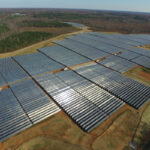Virginia needs to build dozens of square miles of solar panels if there is any hope of reaching the goal of a zero-carbon electric grid by 2045 in Dominion Energy territory and 2050 across the state. The General Assembly can compel the state’s electric utilities to purchase the solar power but it can’t compel anyone to develop the solar farms, especially if local governments are opposed.
Numerous solar projects have been approved — including, most recently, $400 million in a 280-megawatt in Pulaski County, so there’s no question that solar will be a big part of Virginia’s energy future. But are enough projects getting approved?
The odds are looking slim for a $200 million, 149-megawatt proposal by North Carolina-based Strata Solar in Culpeper County. County staff had expressed concerns about the proposed 1,700-acre Maroon Solar power plant, and yesterday the planning commission unanimously recommended denial of the plan, reports the Culpeper Star-Exponent.
Planning Commission member Cindy Thornhill let the Strata developers have it, saying they were in the sales business and trying to satisfy its customer, Dominion, in assisting it in meeting renewable energy goals to receive federal tax credits.
“There are too many what-ifs and too many assumptions. We want protection up front,” she said. “This is our community— it makes us very cautious.”
Meanwhile the Frederick County Board of Supervisor denied yesterday a conditional-use permit for utility-scale solar in a 6 to 1 vote, according to the Winchester Star. Leesburg-based Blue Ridge Energy Holdings had proposed a solar farm on a 320-acre site. Supervisors had approved two solar facilities, but were reluctant to give the OK for a third without having seen the impact of the first two.
“The comprehensive plan says the use of this land should be aimed primarily at maintaining agricultural use,” said Supervisor J. Douglas McCarthy. “This company is neither a farmer of the land in our community, [and] they are not intending to farm the land. They don’t know who is going to own this in the first place. So the first hurdle for me is, in this case, we are not helping a local farmer maintain their land. This is a purely commercial enterprise that they are asking for.”
As of mid-February, Augusta County had rejected 1,000-acre and 560-acre projects, Rockingham County had spurned a 355-acre proposal, and Shenandoah County had turned down a 200-acre project.
Every rejection hurts. There are a finite number of potential sites. Utility-scale solar farms must be located near transmission lines, and developers must be able to find enough contiguous parcels on flat terrain to accommodate hundreds of rows of solar panels. Identifying new sites and assembling the land takes time. Obtaining local regulatory approval takes even more time.
Will Virginia be able to meet its solar agenda on the schedule mandated by the General Assembly? It’s looking iffy right now.


Leave a Reply
You must be logged in to post a comment.